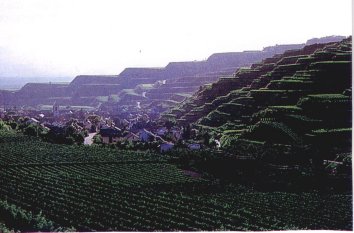
The history of wine-growing:
The first finds of the plant rests of the wine were already discovered 1240 million years before Ch. At the time of 5000-3000 before Ch. Ideogram people operated in the river valleys of Anterior Asia, preparing wine from grapes of the wild wine. Between 2000-750 before Ch. The Phaenozier into Greece introduced the viticulture. There, the wine developed from the salvation beverage to the nation al beverage .The Greeks are thus known as the ancestors of growing wine. In Western Europe begins the wine culture with the establishment of the part of Marseille (France) in 600 before Ch. And by the refinement of the already available wine-shoots by the Greeks. Some time later the Germans only enjoyed the Greek wine. In 50 before Ch. The Romans were responsible for the propagation of the wine-culture from Gallien (France) to Germanien (Germany). Approx in 100 before Ch. The people who live today in Baden refered to the wine from the Linksrheinischen (Rhein = a river in Germany) area, which is called the Elsass (France) today. In the time from 780 after Ch. To 1650 after Ch. The winegrowing experienced its different heights and depths. After this crisis the actual history of wine growing in Baden begins:
In the year 1700 the German wine growing at the climatically favorite areas of the Rhein (south Baden) a new climate. At this time the quality wine also found its promotion by important people and experienced by the still existing monasteries.A very special promoter of the wine growing was Karl Friedrich of Baden (1728-1811)Due to his interference the wine growing in the flatland and on the bad slopes was given up. Instead , he insisted on the flat that the neglected south slopes for example the Kaiserstuhl in Freiburg, the Tuniberg and other growing various areas were planted with the best wine shoots. Also the uniformed cultivation of the property noble wine in the Markgräflerland was started. This was the first "pure set" of a wine with larger stock. Because of this "new development" the wine, which was made from Gutedel-grapes"Markgräfler", possessed a reputation to be better than the other wines of Baden far beyond the borders of the country. Average this wine obtained highest prices on the wine markets.
The position of the wine-growing area of Baden:
 |
The wine-growing area of Baden is situated in the southern of Germany, in Baden Württemberg. It starts in Karlsruhe and ends at the Bodensee. The wine-growing area extends over 4000km length from the lower Traubertal Rhein upward to the Bodensee.With approx. 14000ha Rebfläche it is the 3rd largest of the 11 german wine countrysides. Baden is devided into the following areas: Bodensee , Markräflerland , Kaiserstuhl – Tuniberg , Breisgau , Ortenau , the mountain route of Baden/Kraichgau and the Badische Frankenland. In the wine country Baden are these main wine sorts cultivated: *Gutedel (made the Markgräflerland popular) ca. 7,8% *Müller-Thurgau ca. 29,7% *Grauburgunder ca. 9,2% *Spätburgunder ca. 28,9% *Riesling ca. 8,6% |
The Badener wines belong to the best in Germany. They receive many honors at the wine-awards. Additionally the champagne (bottle fermentation) is very popular. The wines of the Markgräflerland are exported into all corners of the world.
Maintenance of the wine-shoots :
During the cold winter months the wine-shoots have to be cut. In spring the soil will become loosened and the new frowthis are tied up. After the blossom the wines are released from unnecessary leaves, so that the sun can shine well on the grapes.
The wine harvest:
 |
Many people collect the grapes in the wine yards with bucket and shears. The hands become sticky; this is a character of the ripe grapes and the high sugar continent. Then the full buckets are thrown into a container and tilted on the vehicle, which is at the edge of the wine yard. Work begins in the morning hours and often ends in the evening. Then the grapes are delivered to the cooperatives or to the Weingüter. This offers many advantages to the wine farmers. These take over the marketing and the sales and are responsible for the subsequent treatment. Nevertheless it is an old tradition to keep a part of the harvest, to keep manufacture "house wine". |